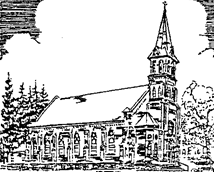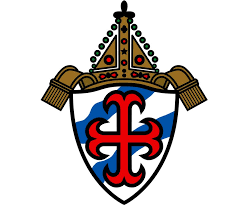The Sanctuary: the five sided apse suggests the five continents, “The Gospel goes forth into all the earth.”
The Central figure is Jesus Christ crucified, flanked by Mary and the “Beloved Disciple,” as depicted in the Passion according to John. There, as in the Mass, the believer is invited to connect with Christ’s death on the cross, and experiences his body and blood, poured out for all.
The other four windows in the apse represent the Gospel writers. (St. Matthew, St. Mark, St. Luke and St. John). The four symbols are mentioned in the Book of Daniel, and are considered prophetic testimony to end times Jesus establishes.
Matthew, whose symbol, the angel, first appears to St. Joseph in the first chapter. He is shown in the temple since his gospel seems written primarily for the Jewish person.
Mark, whose symbol, the lion, represents the strength and boldness of his brief text (probably why he alone carries a scroll rather than a book). The red and purple flowers, and the dead wood in the forest, remind us of the passion and death of Jesus, the focus of his writing.
Luke, whose symbol, the ox, can be found in the manger at Bethlehem. The background is lush and full, since Luke’s Gospel, reveals a Saviour who heals, saves and cares for all.
John, whose symbol, the eagle, reflects the loftiness of this though. He is often called “the theologian.” The garden behind is ordered, as is his work.
The largest part of the altar is a traditional reredos (back screen) intended to draw attention to the central actions of worship on the altar. It contains the tabernacle with chalice and host, above which is a stand for the cross (and probably a monstrance for celebration of Benediction). The shelves are for flowers and candles, and includes decorative grapevines.
The altar is basically everything that is covered by the altar cloth. The table surface is flat and plain, marked only by 5 crosses, where it was anointed by the Bishop.
Beneath the altar is the Agnus Dei, the Lamb of God, on that Book with seven seals, bearing the banner of victory. This is and image of Christ in heaven as witnessed by the author of the Book of Revelation. Thus the rays of light in the background.
On either side of the altar are stalks of wheat and clusters of grapes, symbolic of the fruit and grain that form the bread and wine that becomes the Eucharist.
The Nave. Windows are by F. X. Zettler in Munich. The body of the church is flanked by (12) twelve windows; women saints on the west wall, men saints on the east wall. Most of the windows are filled with the ordered chaos of a Garden of Eden, full of sacred fruit, including grape vines, pomegranite (the interior fruit was blood red seeds, suggesting the cross of Christ, which yields life.
From the front left:
St. Agnes, a young girl martyred in the Roman persecution, bearing the palm branch of victory. She carries a lamb which in Latin is Agnus (Agnes).
Catherine of Siena, Doctor of the Church, whose writings and sanctity even challenged the popes of her time.
A medieval mystic, St. Bridget of Sweden or St. Matilda, or St. Mechtilde of Magdeberg, holding a book of poetry and prayers.
Probably St. Margaret of Scotland, queen, bearing a palm branch.
St. Elizabeth of Hungary, her castle in the distance. She gave it all away feeding the poor, and was one of St. Francis of Assisi’s earliest admirers.
The back window is St. Cecilia, another early Roman Martyr, who went to her death singing, patroness of music.
Front right is St. Anthony of Padua, portrayed with a lily symbolic of purity and the Christ child, suggesting his simple intimacy with Jesus, one of the first Franciscan theologians.
St. Francis of Assisi, bearing the wounds of Christ (stigmata) which he carried on his body the last years of his life. It was said he could never be in a room with a crucifix without weeping.
St. Dominic, founder of the Dominicans, who first spread rosary devotions.
St. Peter, apostle, who wrote several letters in the New Testament (the book), and holds the keys of the kingdom given him by Christ.
St. Aloysius Gonzaga, one of the first to join the Jesuits, who died at the age of 19.
St. Henry, King of Bohemia, credited with establishing the church in that land. One does notice that most of the windows’ patrons are named after the saint represented above, suggesting a hint of pride or gratitude, in the choices made, rather than mere devotion.
The above information or history was done by Fr. Michael Martin from the Catholic Information Center in Grand Rapids. He took an interest in the architecture of this church when he switched places one weekend with Fr. Charles Brown, former pastor of St Joseph’s.



